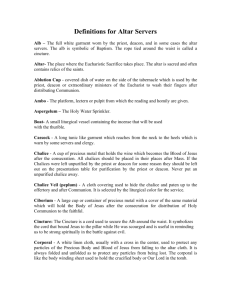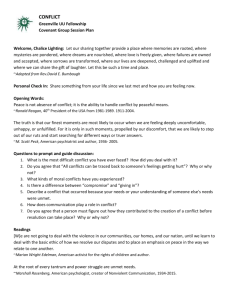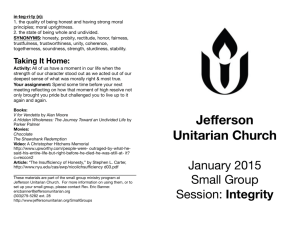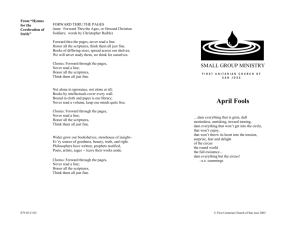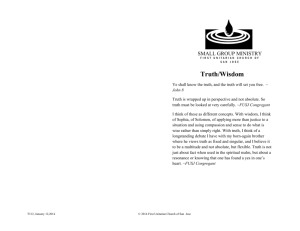A silver chalice and paten problem by Robert Owen Evans
advertisement
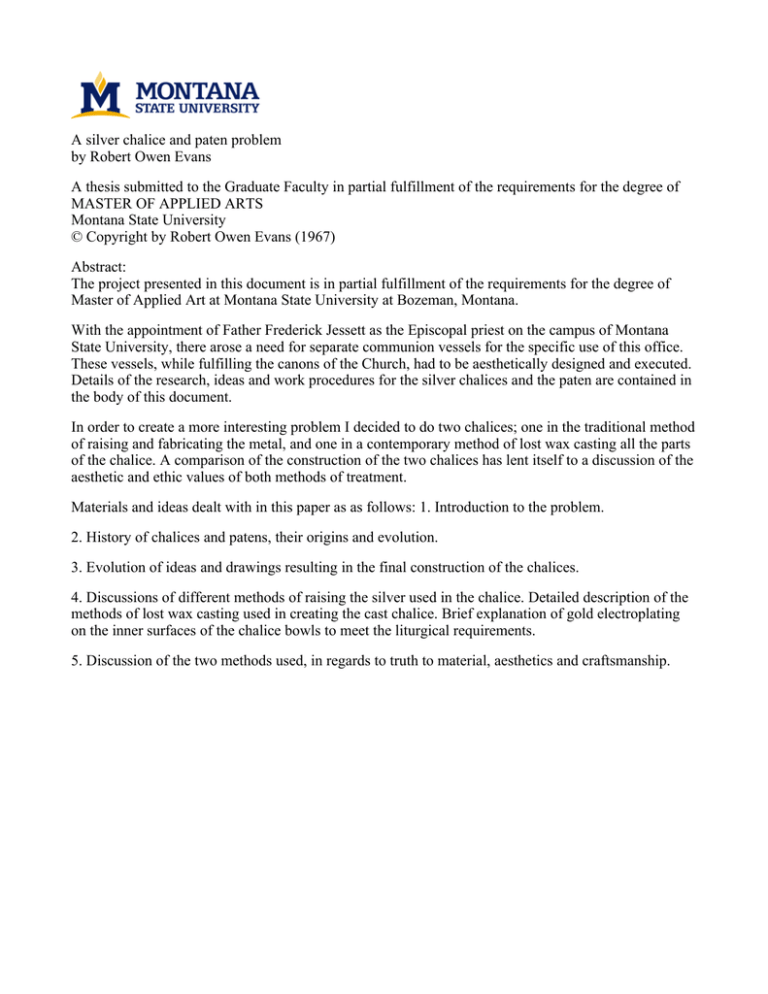
A silver chalice and paten problem by Robert Owen Evans A thesis submitted to the Graduate Faculty in partial fulfillment of the requirements for the degree of MASTER OF APPLIED ARTS Montana State University © Copyright by Robert Owen Evans (1967) Abstract: The project presented in this document is in partial fulfillment of the requirements for the degree of Master of Applied Art at Montana State University at Bozeman, Montana. With the appointment of Father Frederick Jessett as the Episcopal priest on the campus of Montana State University, there arose a need for separate communion vessels for the specific use of this office. These vessels, while fulfilling the canons of the Church, had to be aesthetically designed and executed. Details of the research, ideas and work procedures for the silver chalices and the paten are contained in the body of this document. In order to create a more interesting problem I decided to do two chalices; one in the traditional method of raising and fabricating the metal, and one in a contemporary method of lost wax casting all the parts of the chalice. A comparison of the construction of the two chalices has lent itself to a discussion of the aesthetic and ethic values of both methods of treatment. Materials and ideas dealt with in this paper as as follows: 1. Introduction to the problem. 2. History of chalices and patens, their origins and evolution. 3. Evolution of ideas and drawings resulting in the final construction of the chalices. 4. Discussions of different methods of raising the silver used in the chalice. Detailed description of the methods of lost wax casting used in creating the cast chalice. Brief explanation of gold electroplating on the inner surfaces of the chalice bowls to meet the liturgical requirements. 5. Discussion of the two methods used, in regards to truth to material, aesthetics and craftsmanship. • A SILVER CHALICE AND PATEN PROBLEM ' ■ ■ b y Robert Owen Evans A thesis submitted to the Graduate Faculty in partial fulfillment of the requirements for the degree . : of . ■MASTER OF APPLIED ARTS Approved: Faduate-D e a n • X MONTANA STATE UNIVERSITY Bozeman, Montana June, 1967 ACKNOWLEDGEMENTS . M r o John Wr. Bashor and the staff of the School of Art of Montana State- University The Reverend Father Frederick Jessett of Saint James Episcopal Church, Bozeman, Montana The Reverend Father Ernest Badenoch of Saint James Episcopal Church, Bozeman, Montana The Reverend Father Edward E„ Courtney of the Newman Center, Bozeman, Montana Mrs. Po C . Gaines of Bozeman, Montana Annette Evans, my wife TABLE OF CONTENTS Page Vita - v . ■ 1 C Acknowledgements - - - - - _ _ List of Illustrations vi viii Abstract ±x Introduction - x History of Chalice'and Paten I Evolution of Ideas and Drawings - - _ - _ _ 10 Construction 17 Conclusion 24 Literature Consulted - - - - - - - - - - - - - - - - - - 26 LIST OF ILLUSTRATIONS Illustration N o . ' I 'Raised. Chalice Page ii II Silver Paten ill III Cast Chalice Iv .Raised ChaliceDesigns . 11 Cast Chalice Designs 14 IV V ix : ABSTRACT The project presented in this document is in partial fulfillment of the requirements for the degree of Master of Applied Art at Montana State University at Bozeman, Montana. With the appointment of Father Frederick Jessett as the Episcopal priest on the campus of Montana State University, there arose a need for separate communion vessels for the specific use of this office. These vessels, while fulfilling the canons of the Church, had to be aesthetically designed and executed. Details of the research, ideas and work pro­ cedures for the silver chalices and the paten are contained in the body of this document. In order to create a more interesting problem I decided to do two chalices; one in the traditional method of raising and fabricating the metal, and one in a contemporary method of lost wax casting all the parts of the chalice. A compar­ ison of the construction of the two chalices has lent itself to a discussion of the aesthetic and ethic values of both methods of treatment. Materials and ideas dealt with in this paper as as follows: 1. Introduction to the problem. 2. History of chalices and patens, their origins and evolution. 3. Evolution of ideas and drawings resulting in the final construction of the chalices. 4. Discussions of different methods of raising the silver used in the chalice. Detailed description of the methods of lost wax casting used in creating the cast chalice. Brief explanation of gold electroplating on the inner surfaces of the chalice bowls to meet the liturgical requirements. 5. Discussion of the two methods used, in regards to truth to material, aesthetics and. craftsmanship. INTRODUCTION The problem originated in 1966 while Father Jessett and. I were discussing my interests in the fields of jewelry, silversmithing and liturgical art. Father Jessett wanted a set of communion vessels for the specific use of the Episco­ pal church on the campus of Montana State University. I agreed to accept the commission. We discussed various materials such as enameled copper, enameled silver and sterling silver. I had experimented with copper raising and. enameling to prepare myself for the feel of metal before attempting sterling silver.< I also experi­ mented. with enameled bases. Eventually the idea of enameling was abandoned because the chalice was to be transported, every time it would, be used, and the danger of chipping, and cracking to the enamel was apparent. Sterling silver was finally chosen because of its ease of repair, availability and. its acceptance as a proper material by the Church. T The only requirements made were the extreme dimensions of the chalice and paten. The chalice could, not be over 8^1/2 inches tall and. not over 4-1/2 inches in diameter. The paten (■ could not exceed 8 inches in diameter. Father Jessett. recom­ . mended that the chalice be not too large as the number of active communicants on the campus was not enough to warrant the use of a large chalice. Before I could undertake the raising of the silver chalice, there remained the necessity of finding a donor for f xi this expensive project. Father Jessett referred me to Father Badenoch of St. James Church, Bozeman, Montana. Within a few weeks-, Father Badenoch referred me to Mrs. P. C. Gaines. Mrs. Gaines was very pleased to donate the neces­ sary funds for the chalice and paten to be done in memory of her husband, P. C. Gaines, former acting president of Montana State University, who had passed away that fall. Both Mrs. Gaines and Father Jessett gave me complete freedom in design­ ing the chalice and paten. This project is primarily a problem.in aesthetic design. I have tried to design chalices modern in design, yet grace­ ful and. timeless. \ HISTORY OF CHALICE AND PATEN Among the necessary requisites for the celebration of the Eucharist are the. chalice and its appurtenances, the paten, pall, corporal, purificator, burse, veil and cruets. The chalice and paten occupy the first place of honor among the sacred vessels, for in the chalice the precious blood of Christ is consecrated, and on the paten the glor­ ious body of the Lord is placed. No reliable information has been preserved for us regarding the vessel used by Christ at the Last Supper. So far as it is possible to collect any information regarding the chalices in use among early Christians, the evidence seems to indicate the prevalence of glass, though cups of precious ^ metals, base metals, ivory, wood, and even clay were also in use during the early years of ^,Christianity.- The general use I of the precious metals had developed by the fourth century. It is certain that from the earliest times' efforts were made to have the sacred vessels manufactured, of precious material, mostly of gold and silver, and artistically orna­ mented. Chalices were frequently enameled and set with pearls and gems. Chalices of glass were also used in some places, but they were exceptions to the rule and used I Cross, F. L., ed. "Chalice," The Oxford Dictionary of the Christian Church (2nd ed.), I , 260. 2 chiefly in cases of necessity. Chalices of wood, bone, clay, stone, brass, copper and pewter were condemned by most synods before the end of the tenth'century, although their use did not altogether cease.' EARLY CHALICES: The three parts of the chalice (cuppa=goblet; nodus=knob or handle; pes=foot) were, in different periods of art, quite different in shape. Regarding shape, our principal informa­ tion of the first and second centuries is derived from repre­ sentations, said to be meant for Eucharistic chalices, which are found in early mosaics, 'sarcophagi and other monuments of ■ Christian art. The earliest form of chalice, frequently depicted in the catacombs, consists of a stemless footed bowl with two handles. ■ The chalices of the Romanesque period are of considerable size, and they are often, though not always, fitted with han­ dles, which, it is easy to understand, would have afforded additional security against accidents when the sacred vessel was put to the lips of each communicant. In a rude and bar­ barous age, the practical difficulties of Communion without spillage must have been considerable. The device of using a 9 -jHebermann,' Charles G., Pace, Edward A., Fallen, Conde B., Shohan, Thomas J.,' and Wynne, John, eds. "Chalice," The Catholic Encyclopedia (special ed.), III, 561-63. 3 pipe or reed extending from the chalice for the Communion of both Clergy and people was frequently adopted. To this day at the"Solemn Papal High Mass, the chalice is brought from the altar to the Pope at his throne, and the Pontiff absorbs its contents through a golden pipe. Of chalices earlier than the time of Charlemagne, the existing specimens are so few and so doubtful that a gen­ eralization of the type most commonly used is almost impos- \ sible. Chalices of this period were sometimes seven inches in height but as much as nine and a half inches in diameter, and the bowl was capable of containing nearly three pints of liquid. The broadening of the cup and firm and wide base indicate a development which is noticeable in nearly all the chalices of the Romanesque period. It may be added that although these double-handled' cups of precious metal were no doubt primarily intended for the Communion of the people, they were also on great occasions used by the celebrant in the Holy Sacrifice. It is certain, however, that the chalices commonly used for the private Masses of parish priests and 4 monks were of a simpler character. In the eighth, ninth and following centuries much legis­ lation was devoted to securing that chalices should be made 5Ibid. 4 Ibid., . ' 4 of becoming material. England seems to have taken the lead in this matter, and in any case the' English canons may be quoted as typical of those which soon afterwards were enforced everywhere. Thus, the Council of Chelsea forbade the use of chalices or patens of horn, and the later canons enjoined that all chalices in which the "housel is hallowed" should be of molten work and that none should be hallowed in a.wooden ves­ sel. Horn was rejected because blood had entered into its composition. Probably the most famous decree was that inclu­ ded in the Corpus Juris: "that the chalice of the Lord, to­ gether with the paten, if not gold, must be entirely made of silver. If, however, anyone is so poor, let him at least have a chalice of pewter. The chalice must not be made of brass or copper, because it generates rust. And, let no one presume to say Mass with a chalice of wood or glass. From the eleventh century onwards, sufficient chalices and representations of chalices survive to enable us to draw conclusions regarding their evolution of form. A round node, short stem, broad firm base, and wide, rather shallow cup are characteristic of the earlier period. In the thirteenth century, while the cup of the ordinary chalice still remains broad.and rather low, and. the base and node are circular, we find, a certain development of the stem. 5Ibid. 5 On the other hand, the cup, in a large number of examples of the fourteenth century, tends to assume a conical or funnel shape, while the stem and node become angular, or prismatic in section, generally hexagonal. The base is often divided into six lobes to match the stem, and the node itself is sometimes resolved into a group of studs or bosses, which in certain fifteenth-century specimens give place to a mass of arcading and architectural ornament set with figures. The stem is at the.same time elongated and becomes much taller. Under Renaissance influences, the ornamentation in the more sumptuous specimens of chalices if often excessive, spending itself in the form of figured repousse work' upon ' , the base and stem.. The cup almost invariably assumes a . . tulip shape, which continues during the seventeenth and . eighteenth centuries, while the chalice greatly increases in '■ height. With those in the seventeenth century, often went a very thin stem, or again a quite inadequate base, so that many chalices of this.period leave the well-founded impres­ sion of being either fragile or top-heavy. THE PATEN: The Eucharistic vessel known as the paten, is a small shallow plate or disc upon which the host is offered to God. at the Offertory of the Mass, and. upon which the consecrated, host is again placed after the breaking of the bread. A 6 The word paten comes from a Latin form patina or patena, evidently imitated from the Greek. It seems from the begin­ ning to have been used to denote a flat open vessel of the nature of a plate or dish. Such ■open vessels in the first centuries were used in the service of the altar. These patens, weighing twenty or thirty pounds, were of sufficient size to take large loaves offered by the congregation and also to distribute the consecrated fragments which, after the loaves had been broken by the celebrant, were brought down to the communicants, who in their own hands received each a por­ tion from the paten. However, for many centuries, the host has no longer been broken oyer the paten, but over the •chalice.^ When, towards the ninth century the zeal of the faithful regarding the frequent reception of Holy Communion very much declined, the system of consecrating the bread offered by the congregation and of distributing Communion from the, paten seems to have changed, gradually, and the use of the large and pro­ portionately deep paten fell into abeyance. It was probably about the same time that the custom grew up for the priest himself to use a paten at the altar to contain the host, and lessen the danger of scattered particles after the Fraction. This paten, however, was of much smaller size and resembled 6Ibid., V o l . XI, 541. 7 those with which we are now familiar. Some rather doubtful specimens of the old ministerial patens are preserved in modern times. Some of these patens are highly decorated. In the altar patens of the medieval period we usually find a more marked central depression than is now customary. This well or depression is usually set round with ornamental lobes; seven, ten or more in number. At the present day, hardly any ornament is used or permitted. The corresponding vessel in the Eastern Orthodox Church, the discos, was larger 7 and often possessed a foot. The outer rim of the paten should be thin and. sharp so that fragments of the bread.may be easily gathered up; the inner cavity should be shallow and without border so that the ■ particles of the host may be easily brushed into the chalice. RELIGIOUS■MEANINGS:' , The mystical meaning of the chalice and the paten is to be found chiefly in the formula of their consecration and in the use that is made of them. The chalice accordingly recalls to our mind that sanctified chalice which God once filled with grace. In the sacrificial cup of the Sacred Heart of Jesus is contained the Precious Blood of our redemption. Into and from this Sacred Heart once flowed and will flow for all eternity 7 Cross, op. cit.«, p. 1024. 8 that Precious Blood, which ransomed and redeemed us. The paten reminds us of the gold and silver plates of the Old Testament upon which, according to the Lord's direc­ tion, various pieces of wheaten meal were brought to the altar. Lastly, the chalice and the paten jointly represent the sepulcher, within whose recesses the Lord reposed, in death after accomplishing the great and painful work of redemption; the Church prays, that these vessels, "by the grace of the Holy Ghost, may become a new sepulcher for the body and blood of the Lord."® USE OF MATERIALS: Considering the use to which these vessels are put, the Church has ordained that they be made only of the best, the most noble and. the most, precious metals. Brittle, unsafe, and inferior materials are not to be used in their construction, i. e., glass, which breaks easily, wood, which is porous and would absorb the wine, brass and copper, which are given t o ' corrosion, lead and iron, which are of little value. The chalice proper (the cup) must be of gold or silver; only in exceptional cases, on account of poverty, are chalices of pewter allowed. • If the cup is of silver or pewter, then at ®Gihr, Rev. Dr. Nicholas. The Holy Sacrifice of the Mass.•St. Louis, Missouri: B. Herder Book Co., 1949. ■ 9 least the interior must'be gilt. The paten must be of the same material as the cup of the chalice and also gilt.^ That the sacred, vessels be made of gold or at least be gilt is also recommended, for symbolical reasons. Gold, as . the most excellent and. precious of the metals, is a symbol of that which is most noble and of the highest order. The Magi presented Christ with gold; thus, the golden or gilt sacred vessels denote the royal dignity and power of our ■divine high priest. As the noblest of the metals, gold also symbolizes the heavenly wisdom and love which Christ offers for us on the altar. EVOLUTION OF IDEAS AND DRAWINGS The•most difficult.part of this problem was to design the chalice to meet liturgical standards and. still achieve a fresh and contemporary form. I wanted to depart from the long thin stem and wide foot so frequently used in raised chalices. I started by thickening the stem (Fig #1) and incorporating the cross motif. sent a very inspiring design. However, this did not pre­ The cross motif has recurred so often on commercial chalices as to lessen the richness of the intended meaning. I then became involved with cones and inverted cones (Fig #2) because they presented numerous design possibilities. I elongated, thickened, shortened and expanded the cones so as to produce many variations until one with favorable proportions was reached. However, I was still dissatisfied with the symbolism because it was lacking the strength of meaning I desired. I worked with symbolism and forms to create a chalice with more meaning than is embodied on most chalices I have observed. Many contemporary chalices have incorporated into their design abstract symbols such as a cross, Christus Rex3 sheaves of wheat, loaves of bread and bunches of grapes as symbols of the Communion. To me these images are unimagi­ native, shallow and repetitive in their use. I consulted Father Jessett about the Greek translations for several phrases appropriate to my needs. I chose Greek because it was the language used, in the original writing of 12 the New Testament. I was very enthusiastic about the idea of using the Greek letters on the node of the chalice. Some of the phrases for which Father Jessett gave me translations are as follows: wine of God. (Greek) OINOZ OEOY water (Greek) YAfiP wine (Greek) OINOE bread of God (Greek) APTOZ OEOY Jesus (first 3 letters Greek) IHS Jesus of Nazareth, rr +■ \ King of the Jews i^atinj INRI first two letters of Christ (Greek) XP I started with IHS and used conical shapes (Fig #3), but the IHS was another symbol which I found to be overused. I then explored the idea of designing a set of crosses as identifying symbols, for the twelve disciples. Using the tra­ ditional signs of the disciples, I redesigned each symbol into the form of a cross (Fig #4).. Three of the disciples had crosses as personal identifying symbols. Using those in combination with the Greek node I designed a chalice which was acceptable to Church canons, but it was far too compli­ cated because of the numerous symbols and was also causing the chalice to lose its simplicity and grace. Following this, I returned, to the idea of the Greek node using OINOZ OEOY and spent much more time adjusting the 6- 13 proportions so that the cup, base and node would blend as a single graceful form. I worked with the symbolism of the Last Supper and the Passion and all who were associated with it, but it involved too many symbols to be incorporated into a single chalice. I began eliminating symbol after symbol and idea after idea until narrowing it. to the twelve disciples and crown of thorns. I kept the crown of thorns motif because it fit naturally with the. shape of the node and did not make the appearance of the chalice too busy. My early designs for casting combined raised-silver cups with cast bases (Fig #5 and #6). In the first drawing I planned to use the.shape of crosses recessed into the wax model to create a meaningful texture in the cast stem. How­ ever, this would have been far too textured and would have appeared, too dark from oxidation to be acceptable as a stem for a chalice. In thinking further on symbolism I was intrigued by the idea that the Trinity is represented by three circles in a pyramid shape, each one intersecting the other two. The only other way it could be represented properly is by placing the intersecting circles around a conical or cylindrical shape. On the base (Fig #6). the three circles intersect each with the other two and each one symbolizes its counterpart to the > Trinity, the polished ring for the Father, the thorns for 15 the Son and the circle of fire for the Holy Ghost. This chalice idea was unsuccessful for a number of rea­ sons . First, the crown of thorns was used twice and would cause confusion. The design in the base would call for a casting far too heavy for a chalice. Finally, the use of too much symbolism ruined the contemporary spirit I was trying to achieve. I then decided, to design a completely cast chalice as this would, result in a chalice completely different in character from the raised, chalice on which I had already begun work. I went back to my original idea of symbolizing the Passion of our Lord, and the Last Supper. Christ was at the Last Supper, but furthermore, he was in the company of the twelve disciples. With this thought in mind I designed a cast chalice with the twelve symbols surrounding the cup - ' representing the disciples. entwining crown of thorns. is acceptable (Fig #7). I also designed the base of an This chalice had no node, which The cup idea was excellent but the base did not harmonize with it. Consequently, I abandoned the base idea and tried to put twelve corresponding bodylike shapes around the base and. used the crown of thorns node. . The base was too geometric and not organic as were the node and cup. (Fig"#8) For the final chalice I used the cup with the twelve symbols for the disciples and the crown of thorns. For the 16 base I employed a simple cone shape with wax run and tooled over it so it would take on the organic appearance of the cup and node. The base, cup and node of the cast chalice are slightIy oxidized. CONSTRUCTION In the construction of the fabricated chalice I began by using paper shapes of the same size I planned for the finished silver. I did this in order to check the three- dimensional relationships of the cup, base and'node against the working drawing. I used the paper model of the node for a pattern and cut a piece of silver that shape. After soldering square I sterling silver wire into the shapes of the Greek letters, OINOZS OINOE, I soldered them on the flat silver sheet that was to be the node. I very carefully bent the flat silver sheet into the conical node and soldered the seam together. RAISING: The sterling silver cup, base and paten began as a flat six-inch square of eighteen gauge silver. Starting with the square, I found the center by crossing the diagonals and center punching the intersection. Using dividers I scribed a six-inch circle and with bench shears, designed for cutting curves, I cut out the disc. After filing the edges and truing the circle I began the raising process. Before start­ ing the actual hammering process, I calculated the number of angles and. courses per angle by analyzing the curve of the shape into straight line segments. I used the Bennett or angle method of raising which consists of raising by courses and angles. I started by holding the silver disc at an 6* 18 angle against a T stake and hammering successive blows around the piece from the center outwards. As a result of this, the metal is trapped between the hammer face and the stake causing it to compress and. rise. The first course of the first angle began at a scribed line about one inch from the center mark. I laid the metal against the stake at a forty-five degree angle on the scribed line and struck the silver above the point of contact. Con­ tinuing the blows and rotating the disc, I worked to within three-eighths of an inch of the outer edge. Taking the shape to a sand bag, I struck blows with a collett hammer on the edge in order to thicken the rim. After thickening the edge I blocked it with a leather mallet to remove irregular dents,' scrubbed it with pumice, coated the piece with flux and annealed it to a dull red glow before quenching it in an acid bath. This complete cycle from hammering to annealing is called a course. It took four courses to finish the first angle. The second angle started two. and one-half inches from the center of the cup. 'The angle of the silver against the stake was increased slightly in order to increase the rise of the angle. It took five courses to complete the second angle. The third and hardest angle was started three and threefourths of an inch from the center and took seven courses to / finish. The paten was completed in a single angle as was the 19 base, although the base had a small angle one-half inch from the bottom to form a foot. After completing the raising I planished the vessels. Planishing is a process of removing small dents and scratches with a highly polished, round-faced hammer over a highly polished stake. This process also smoothes the surface and hardens the metal. In doing this I had to be sure that the stake was the same shape as the inside of the vessel. In planishing I did not have to work in any special pattern as planishing can be carried out over the entire piece at any place the artist desires. It is this process that gives a piece its distinctive hand-made appearance. After planishing all parts. I set them up on an asbestos soldering block and bound them together with binding wire in order to solder them without having them shift and slip. In soldering these big pieces I used the largest tip available for the Prestolite soldering equipment in order to obtain maximum heat and a brushy flame. After the pieces were hot enough I drew medium solder wire around the joints. nicely and was easily cleaned -and polished. It flowed Once I had the pieces attached to one another, the tactile qualities of the combined pieces were very exciting. I polished, the piece and found that the lettering on the node required more polish­ ing time than the remainder of the chalice. The next step was the electroplating to put an eighteen 20 karat gold lining on the•inner surface of the cup. The bright silver polish of the outside created a pleasing con­ trast with the lining of the cup. CASTING: The cast chalice took longer to complete than the fabri­ cated chalice, not because it was more difficult, but because of the technical problems to overcome. V I started .by casting an investment cup shape in a rubber bowl having a pleasing form. half plaster and half silica. The investment was approximately This form had a lag bolt fast­ ened to it for a handle. .When the investment form had set, I heated it to two hundred degrees Fahrenheit in an oven to drive out excess water that would cause air bubbles in the wax coating. I used an old. deep-fat fryer in which to melt the wax which was three parts beeswax to one part paraffin.' Holding the mold by the handle, I dipped the form into the molten wax in much the same manner one would dip candles. When I had a sufficient coating of wax built up, I let it cool before applying the texture and twelve symbols. Before I could make wax models for the base and node I •_ . had. to pour large wax sheets from which they would be cut. It was necessary to pour thin wax sheets for the base because of the problem of weight. is 10:1. . I, The ratio of wax weight to silver As in the raised chalice, paper was used for 21 patterns. The wax was welded and tooled with hot spatulas, spoons and dental tools. Sprues of one-fourth inch round wax rods were attached to channel the molten silver into the mold. Care had to be taken to be certain that there were no sharp angles or rough surfaces in the sprues as they would, cause the molten silver to agitate and back up making the cast incomplete. Investment was mixed in a large rubber bowl and placed under a vacuum to pull all the air bubbles from the mixture. The wax model was painted with tincture of green soap which was diluted with water and more alcohol. This reduced the surface tension and eliminated bubbles in the cast. The vacuumed investment was then poured into a stainless steel • flask which held the wax model. The flask with the invested wax was then put under the vacuum to pull out any air which might have stuck to the model during investing. .The vacuumed flask with model was allowed to set for a minimum of two hours although it could, have set for weeks until I was ready for the burnout. The burnout took place in;a kiln starting with a heat of two hundred degrees Fahrenheit to drive out excess water. The flask was upside down to allow the wax to flow out when the temperature was raised to approximately three hundred fifty degrees Fahrenheit. When five hundred degrees t 22 • Fahrenheit was reached, the flask was inverted so that the excess wax could burn out in the form of smoke and flame. The burnout was completed in six to eight hours when the temperature reached thirteen hundred degrees Fahrenheit. The flask was then allowed to cool to between nine hun­ dred. and. one thousand, degrees Fahrenheit before being taken to the .casting machine where the silver had been melted in a crucible attached to the machine. When the silver was hot enough to swirl, the machine was turned loose and. the silver was thrown into the mold by centrifugal force. was allowed to spin to a stop. The machine After about five minutes, when it had stopped turning, the flask was removed by tongs and plunged into water, which seeped into the investment and formed, steam to blow it away from the silver cast. The cast was then scrubbed and pickled, the sprues were removed, and the piece was rough polished. After all the pieces were rough polished with tripoli, they were wired to­ gether with binding wire and soldered together with mediumflow silver solder. The chalice was then pickled and polished with rouge to obtain a high finish. It was then.gold plated on the inner surface of the cup when finished. ELECTROPLATING: The electroplating was done with a Hoover and Strong electroplater which changes household current into the six 23 volt direct current needed for plating. I used.a commercial eighteen karat yellow gold plating salt solution with a home made eighteen karat yellow gold anode. The cup of the chalice was filled with gold-plating solution, the cathode attached to the base and the gold, anode agitated about in the cup for approximately five minutes. This process was repeated three times in order to build up a heavy gold inner surface on both chalices and paten. CONCLUSION The casting and raising of metal has been practiced for centuries. times. Its beginnings can be traced back to prehistoric We know that the Egyptians and Incas used the methods of raising, fabricating and lost wax casting and handled them all equally well. ' 'In constructing these chalices I have found, that the processes used, i. e. casting and. raising, could, not be sep­ arated from the design or material. If the result of these methods of construction was to be an object of aesthetic value, the design, process and materials had to be integrated to create a uniform whole. I have designed and executed these chalices in such a manner as to enhance the unique character­ istics of both methods.• During the preliminary studies I placed major emphasis on design and not on technical details concerning the construction process. Often metalsmiths become, too preoccupied with a step-bystep sequence of the working process, so much in fact, that the end products become technical projects and. not works of art. I had been involved, with both raising and centrifugal casting methods before starting my graduate work and I feel that during that time I outgrew the technical involvement part of my development. In working on this project I found that raising is one of the most rewarding skills of the metalsmith, primarily because the subtle changes of form are so personal and warm. 25 Hand-raised metal seems to acquire a human quality because the craftsman becomes so .involved with the working of it. I believe that a cast piece should possess certain qualities to distinguish it from a fabricated piece. The organic flowing appearance of the cast chalice could, not have been achieved by any other method and is therefore a valid reason for having been cast,. A design worked, in wax has unlimited possibilities ih shape, form and. texture; wax can be pulled, stretched, melted and tooled, in many various ways. I have concluded that the artist-craftsman in metal has two distinct processes from which he may choose, casting and fabricating; each exhibits qualities peculiar to itself and each possesses great potential as an aesthetic medium. LITERATURE CONSULTED Berryman, Nancy D. "Religion and the Symbol in Art." Creative Crafts, IV (Sept.-Oct. 1963), 18-23. Berryman, Nancy D. "Ritual Art and Church Restrictions." Creative Crafts, IV (May-June 1963), 20-25. Berryman, Nancy D. "Symbolism and Ritual Art." Creative Crafts, IV (Jan.-Feb. 1964), 7-11. Graver, Margret. "An Ancient Method Goes Modern." Craft Hori­ zons , IX (Winter 1949), 15-17. Cross, F. L., ed. The Oxford Dictionary of the Christian Church. London! Oxford University Press^ 1958. Gihr3 Rev. Dr. Nicholas. The Holy Sacrifice of the Mass. St. Louis, Missouri: B. Herder Book Co., 1949. Herbermann, Charles G., Pace, Edward A., Fallen, Conde B., Shohan, Thomas J. and Wynne, John, eds. The Catholic Encyclopedia. New York: The Encyclopedia Press, Inc., 1911. ■ Krevitsky, Nik. "The Jewelry of Bob Winston." Craft Horizons, XXII (Jan.-Feb. 1962), 10-13. "La chapelIe des Soeurs de Saint-Vincent, a Werken." Art D 'Eglise, XXXI (March 1963), 330-331. Marggraf, Zella Eckels. "Paul Pancritiuss .Goldsmith." Creative Crafts, II (Jan.-Feb. 1962), 16-19. Maryon, Herbert. Metalwork and Enamelling. London: Chapman and Hall LTD, 1959. Michaelis, Diana Tead. "The Flowering, of Church Art in Boston." Craft Horizons, XVIII (May-June 1958), 29-31. Roysher, Hudson. "The Ecclesiastic Metalsmith." Crafts, I (April-May 1960), 15-17. Creative Roysher, Hudson. "The Ecclesiastic Metalsmith." Creative Crafts, I (Aug.-Sept. I960), 10-13. Story, Mickey. Centrifugal Casting as a Jewelry Process. Scranton, Pennsylvania: International Textbook Company, 1963. . 27 "The Sculpture of Guiseppe Tarantino." Liturgical Arts, XXXIV (May 1966), 114. Thomas, Richard. Metalsmithing. New York: Chilton Company, 1963. von Neumann, Robert. The Design and Creation of Jewelry. Philadelphia: Chilton Books, 1963. I Warnach, Dr. Walter. "L’orfevre Hein Wimmer." Art D 'Eglise, XXXII (February 1964), 66-75. Whittembre, Carroll E., Symbols of the Church. Boston, Mas­ sachusetts: Whittemore Associates, Inc., 1962.
